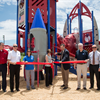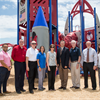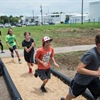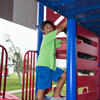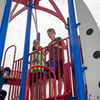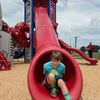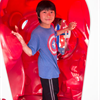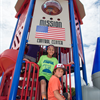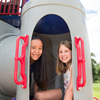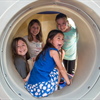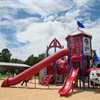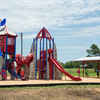All work and no play? Not for these pint-sized explorers
2016-06-24
To many engineers and scientists at Johnson Space Center, their workplace is a life-sized playground. Now, that’s possible for all the mini-astronauts who rushed straight to the Gilruth Center’s new playground’s tallest slide to play “mission control.”
The new addition was unveiled June 22 by JSC Director Ellen Ochoa. More than 30 children from JSC Starport Summer Camps watched with barely contained excitement as the formalities took place. After a brief countdown, the youngsters raced for the playground.
“I feel like a mini-astronaut. It’s really cool!” said a youth camper as she went down the slide.
“It’s been a long road to get it done and a lot of work, but seeing the excitement of the children is the best part,” said Steve Williams, deputy Operations manager of the NASA Exchange.
NASA Exchange Project Manager Barbara Jones and her team were eager to replace the dilapidated playground, installed in 1998, with one that would “evoke questions and curiosity about spaceflight.” The team wanted a playground that would help children develop motor skills, be corrosion-resistant, Americans with Disabilities Act accessible and, above all, be thematically linked to the JSC’s identity as the home of human spaceflight.
The team considered six playground designs before choosing the one proposed by Kraftsman. Bids were accepted in March, and the selection was made in April.
Jones called the two-story playground a canvas for the imagination that her team hopes will become “a destination that people in our community will want to come to.” There are only two or three of these playgrounds in the entire country with this new concept and particular design.
The playground includes a mission control area connected to a space rocket by a transfer tunnel. Mission control has a smaller rocket attached to a side that provides shade, a two-story tubular slide and a tube to facilitate communication with and among the mini-astronauts. The rocket provides access to two slides, the communication tube, gear shifts, radio, steering wheel and various spots that also protect children from the sunlight. The playground contains a swing set with a cover that protects against up to 99 percent of ultraviolet rays.
“This is the first of many improvements, renovations and exciting things we’re doing here in the Exchange,” Jones said. “The playground should easily last 15 to 20 years without the maintenance issues of the past.”
After months of planning, 40 children were invited for a “test launch” of the rocket and mission control playground.
“I encountered a student saying his teacher told him it was fake, that no one has ever been out of the Earth’s atmosphere,” Jones said. “And here he was asking questions because of this playground. It was more of a thought process, not just a playground with a slide, which was what we were looking for.”
Jaira Pereznegron
NASA Johnson Space Center
The new addition was unveiled June 22 by JSC Director Ellen Ochoa. More than 30 children from JSC Starport Summer Camps watched with barely contained excitement as the formalities took place. After a brief countdown, the youngsters raced for the playground.
“I feel like a mini-astronaut. It’s really cool!” said a youth camper as she went down the slide.
“It’s been a long road to get it done and a lot of work, but seeing the excitement of the children is the best part,” said Steve Williams, deputy Operations manager of the NASA Exchange.
NASA Exchange Project Manager Barbara Jones and her team were eager to replace the dilapidated playground, installed in 1998, with one that would “evoke questions and curiosity about spaceflight.” The team wanted a playground that would help children develop motor skills, be corrosion-resistant, Americans with Disabilities Act accessible and, above all, be thematically linked to the JSC’s identity as the home of human spaceflight.
The team considered six playground designs before choosing the one proposed by Kraftsman. Bids were accepted in March, and the selection was made in April.
Jones called the two-story playground a canvas for the imagination that her team hopes will become “a destination that people in our community will want to come to.” There are only two or three of these playgrounds in the entire country with this new concept and particular design.
The playground includes a mission control area connected to a space rocket by a transfer tunnel. Mission control has a smaller rocket attached to a side that provides shade, a two-story tubular slide and a tube to facilitate communication with and among the mini-astronauts. The rocket provides access to two slides, the communication tube, gear shifts, radio, steering wheel and various spots that also protect children from the sunlight. The playground contains a swing set with a cover that protects against up to 99 percent of ultraviolet rays.
“This is the first of many improvements, renovations and exciting things we’re doing here in the Exchange,” Jones said. “The playground should easily last 15 to 20 years without the maintenance issues of the past.”
After months of planning, 40 children were invited for a “test launch” of the rocket and mission control playground.
“I encountered a student saying his teacher told him it was fake, that no one has ever been out of the Earth’s atmosphere,” Jones said. “And here he was asking questions because of this playground. It was more of a thought process, not just a playground with a slide, which was what we were looking for.”
Jaira Pereznegron
NASA Johnson Space Center








